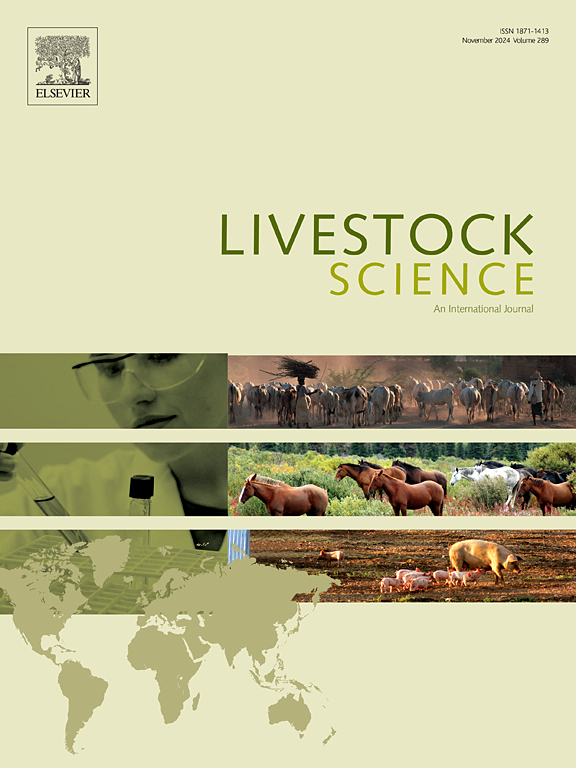Impact of high-protein distiller's dried grains with solubles (HP-DDGS) on early growth benefits and carcass quality trade-offs in pigs
IF 1.8
3区 农林科学
Q2 AGRICULTURE, DAIRY & ANIMAL SCIENCE
引用次数: 0
Abstract
Despite the limited adoption of DDGS in South America, its potential benefits in pig nutrition have not been thoroughly evaluated, we assessed the effects of increasing levels of HP-DDGS in corn/soybean meal-based diets fed to pigs from the initial I nursery phase to the finishing phase on performance, health parameters, and quality characteristics of carcass, pork, and belly. Five hundred piglets were distributed in randomized blocks to five HP-DDGS inclusion levels. HP-DDGS was introduced 14 days into the experiment and maintained until the end of the 147-day experimental period. It replaced corn and soybean meal in isoenergetic diets at increasing levels of 0 %, 10 %, 20 %, 30 %, and 40 %. Increasing levels of HP-DDGS positively affected average daily feed intake (P = 0.001), average daily gain (P = 0.0002), and body weight (P = 0.0003) in the nursery phase, while in the growing and finishing phase negatively impacted feed conversion ratio (P = 0.002 and P < 0.0001, respectively) and body weight (P = 0.018 and P = 0.0003, respectively). HP-DDGS inclusion also positively influenced fecal score; animals fed 40 % HP-DDGS in the nursery phase and 30 % and 40 % HP-DDGS in the growing and finishing phase had highest proportion of well-formed feces (fecal score 1), while those fed 10 % or no HP-DDGS showed more mild diarrhea (fecal score 2) (P < 0.0001 to P = 0.0024). Increased HP-DDGS inclusion levels had a negative impact on body weight at slaughterhouse (P < 0.0001), hot carcass weight (P < 0.0001), chilled carcass weight (P < 0.0001), backfat thickness (P = 0.042), belly weight (P = 0.0002), belly thickness (P < 0.0001), belly external flexibility (P < 0.0001), belly internal flexibility (P < 0.0001), and a* color component (P = 0.037), but had a positive effect on L* color component (P = 0.044). Overall, increased HP-DDGS levels in pig diets modified the fatty acid profile of belly fat. Although this belly fat shows increased oxidation rates and flexibility, it is rendered more suitable for human consumption in terms of health benefits. In this sense, including HP-DDGS in pig diets benefits early growth by improving gut health and reducing diarrhea, enhancing weight gain and fecal consistency. However, high HP-DDGS inclusions levels negatively affected carcass traits. While HP-DDGS improved the polyunsaturated lipid profile of pork, its overall impact on meat quality varied. Therefore, HP-DDGS should be used early in growth, with a transition to a low-fiber diet during finishing to mitigate these effects.
高蛋白酒糟干颗粒及其可溶物(HP-DDGS)对猪早期生长效益和胴体质量权衡的影响
尽管DDGS在南美的应用有限,其对猪营养的潜在益处尚未得到全面评估,但我们评估了从苗期到肥育期饲喂猪的玉米/豆粕型饲粮中HP-DDGS水平的提高对胴体、猪肉和腹部的生产性能、健康参数和质量特征的影响。500头仔猪按5个HP-DDGS添加水平随机分组。HP-DDGS于试验第14天引入,维持至147 d试验期结束。在等能日粮中,它替代玉米和豆粕的水平分别为0%、10%、20%、30%和40%。HP-DDGS添加水平对育苗期平均日采食量(P = 0.001)、平均日增重(P = 0.0002)和体重(P = 0.0003)有正向影响,而对生长肥育期饲料系数(P = 0.002)和P <;0.0001)和体重(P = 0.018和P = 0.0003)。HP-DDGS加入对粪便评分也有正向影响;在苗期饲喂40% HP-DDGS,在生长和肥育期饲喂30%和40% HP-DDGS的动物形成良好粪便的比例最高(粪便评分1),而饲喂10%或不饲喂HP-DDGS的动物表现出更轻微的腹泻(粪便评分2)(P <;0.0001至P = 0.0024)。HP-DDGS添加水平的增加对屠宰场体重有负面影响(P <;0.0001),热胴体重(P <;0.0001),冷藏胴体重(P <;0.0001)、背膘厚(P = 0.042)、腹重(P = 0.0002)、腹厚(P <;0.0001),腹部外柔度(P <;0.0001),腹部内部柔韧性(P <;0.0001)和a*颜色成分(P = 0.037),但对L*颜色成分有正向影响(P = 0.044)。总体而言,猪日粮中HP-DDGS水平的增加改变了腹部脂肪的脂肪酸分布。虽然这种腹部脂肪显示出更高的氧化率和灵活性,但就健康益处而言,它更适合人类食用。从这个意义上说,在猪日粮中添加HP-DDGS可以通过改善肠道健康和减少腹泻、增加体重和提高粪便稠度来促进猪的早期生长。然而,高HP-DDGS夹杂物水平对胴体性状有负面影响。虽然HP-DDGS改善了猪肉的多不饱和脂肪谱,但其对肉品质的总体影响存在差异。因此,HP-DDGS应在生长早期使用,并在育肥期过渡到低纤维饮食,以减轻这些影响。
本文章由计算机程序翻译,如有差异,请以英文原文为准。
求助全文
约1分钟内获得全文
求助全文
来源期刊

Livestock Science
农林科学-奶制品与动物科学
CiteScore
4.30
自引率
5.60%
发文量
237
审稿时长
3 months
期刊介绍:
Livestock Science promotes the sound development of the livestock sector by publishing original, peer-reviewed research and review articles covering all aspects of this broad field. The journal welcomes submissions on the avant-garde areas of animal genetics, breeding, growth, reproduction, nutrition, physiology, and behaviour in addition to genetic resources, welfare, ethics, health, management and production systems. The high-quality content of this journal reflects the truly international nature of this broad area of research.
 求助内容:
求助内容: 应助结果提醒方式:
应助结果提醒方式:


